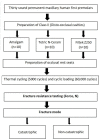Fracture Strength of Composite Rest Seats: An In Vitro Comparative Study of Different Composite versus Amalgam Restorations
- PMID: 37445144
- PMCID: PMC10343307
- DOI: 10.3390/ma16134830
Fracture Strength of Composite Rest Seats: An In Vitro Comparative Study of Different Composite versus Amalgam Restorations
Abstract
Occlusal rest provides support for removable partial dentures (RPD). Rest seats are ideally prepared in enamel, but the abutment teeth might be restored or need restorations. This study compared the fracture strength of abutments restored with composite to amalgam restorations after rest seat preparation. Disto-occlusal cavities were prepared in 30 extracted human maxillary premolars. The specimens were allocated in three groups (n = 10) based on the type of restoration. All the specimens were exposed to thermomechanical aging followed by cycling loading. Fracture strength was tested using a universal testing machine, and then, the fracture mode was recorded. The data were analyzed using Kruskal-Wallis test with a significance level set at 0.05. The fracture mode was recorded as catastrophic or non-catastrophic. The fracture strength between all tested groups showed no significant difference. The highest and lowest fracture strength were recorded on amalgam and Tetric N-Ceram groups, respectively. Composite Tetric N-Ceram showed equal distribution of fracture sites on the restorative materials and teeth, it also displayed the highest number of non-catastrophic fractures unlike other groups where the fracture occurred more within the restorations. The fracture strength of composite was comparable to that of amalgam restorations with prepared rest seats.
Keywords: composite dental resins; dental materials; fracture strength; removable partial denture.
Conflict of interest statement
The authors declare no conflict of interest.
Figures
Similar articles
-
Performance of bulk-fill versus conventional nanocomposite resin restorations supporting the occlusal rests of removable partial dentures: An in vitro investigation.J Prosthet Dent. 2023 Jun;129(6):907.e1-907.e7. doi: 10.1016/j.prosdent.2023.03.024. Epub 2023 Apr 24. J Prosthet Dent. 2023. PMID: 37100650
-
Effects of Resin-modified Glass Ionomer Cement and Flowable Bulk-fill Base on the Fracture Resistance of Class II Restorations: An Original Laboratory Experimental Study.J Contemp Dent Pract. 2021 Apr 1;22(4):342-348. J Contemp Dent Pract. 2021. PMID: 34267000
-
In vitro investigation of the performance of different restorative materials under cast circumferential clasps for removable dental prostheses.Clin Oral Investig. 2012 Dec;16(6):1659-67. doi: 10.1007/s00784-011-0653-5. Epub 2011 Dec 17. Clin Oral Investig. 2012. PMID: 22173722
-
Effect of bulk-fill base material on fracture strength of root-filled teeth restored with laminate resin composite restorations.J Dent. 2017 Aug;63:60-64. doi: 10.1016/j.jdent.2017.05.016. Epub 2017 May 29. J Dent. 2017. PMID: 28571830
-
Longitudinal clinical evaluation of undercut areas and rest seats of abutment teeth in removable partial denture treatment.J Prosthodont. 2011 Dec;20(8):639-42. doi: 10.1111/j.1532-849X.2011.00766.x. J Prosthodont. 2011. PMID: 22182224 Clinical Trial.
Cited by
-
Effect of thermocycling on flexural strength of dental CAD/CAM ceramics of variable thicknesses and structures: an in vitro study.F1000Res. 2025 Aug 14;13:1310. doi: 10.12688/f1000research.157128.3. eCollection 2024. F1000Res. 2025. PMID: 40766904 Free PMC article.
-
Research on the Fatigue Crack Growth Behavior of a Zr/Ti/Steel Composite Plate with a Crack Normal to the Interface.Materials (Basel). 2023 Jul 27;16(15):5282. doi: 10.3390/ma16155282. Materials (Basel). 2023. PMID: 37569991 Free PMC article.
References
-
- Phoenix R.D., Cagna D.R., Defreest C.F. Stewart’s Clinical Removable Partial Prosthodontics, Rest Seat Preparation for Posterior Teeth. 4th ed. CBS; New Delhi, India: 2018. p. 302.
-
- Beaumont A.J., Jr. A clinical view of mandibular premolars in removable partial denture design. Quintessence Int. 1990;21:21–26. - PubMed
-
- Valenti C., Federici M.I., Masciotti F., Marinucci L., Xhimitiku I., Cianetti S., Pagano S. Mechanical properties of 3D-printed prosthetic materials compared with milled and conventional processing: A systematic review and meta-analysis of in vitro studies. J. Prosthet. Dent. 2022;5:S0022-3913. doi: 10.1016/j.prosdent.2022.06.008. - DOI - PubMed
LinkOut - more resources
Full Text Sources




